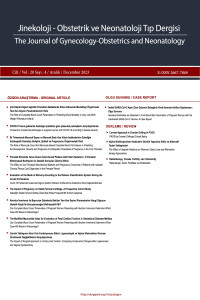Öz
Amaç: COVID-19 tanılı gebelerde hastalığın şiddetine göre plasental patolojileri değerlendirmeyi amaçladık. Gereçler ve yöntem: Bu retrospektif çalışma Nisan 2020 ile Şubat 2023 tarihleri arasında üçüncü basamak bir merkezde gerçekleştirildi. SARS-CoV-2 pozitif olan 3. trimesterdaki 125 gebenin plasentası incelendi. Plasental patolojiler modifiye edilmiş Amsterdam kriterlerine göre sınıflandırıldı. 104 hasta şiddetli olmayan COVID-19 hastalarından, 21 hasta ise şiddetli COVID-19 hastalarından oluşturularak 2 gruba ayrıldı. Hastalığın şiddetine göre plasental patoloji sonuçları karşılaştırıldı.
Bulgular: MVM (maternal vasküler malpergüzyon) ve FVM (fetal vasküler malperfüzyon) patolojileri şiddetli olmayan grupta 90.4% ve 45.2% olarak izlendi. Şiddetli COVID-19 grubunda ise 71.4% ve 19% ile anlamlı olarak daha düşük izlendi (sırasıyla p=0.018 ve p=0.026). Şiddetli grupta gecikmiş villöz olgunlaşma (GVO) oranı 9.5% olarak izlenirken, şiddetli olmayan grupta 1% olarak izlendi ve bu istatistiksel olarak anlamlıydı (p=0.019). İnflamatuar patolojiler ve diğer patolojik bulgular her iki grupta benzer izlendi. Yoğun bakım ünitesine kabul (YBÜ), eşlik eden maternal hastalık, doğum sonrası komplikasyon şiddetli grupta istatistiksel anlamlı olarak daha yüksek izlendi (p<0.05).
Sonuç: MVM ve FVM lezyonları şiddetli olmayan SARS-CoV-2 hastalarında daha yüksek oranda izlenirken GVO lezyonları ve normal plasentalar şiddetli grupta daha fazla izlendi. SARS-CoV-2 hastalarında hastalığın şiddetine göre farklı plasenta patolojilerinin bulunması, hastalığın akut veya kronik seyri ile ilişkilendirilebilir.
Anahtar Kelimeler
Kaynakça
- 1. Cucinotta D, Vanelli M. WHO Declares COVID-19 a Pandemic. Acta Biomed. 2020;91(1):157-60. 2. Ezechukwu HC, Shi J, Fowora MA, Diya CA, Elfaki F, Adegboye OA. Fetoplacental transmission and placental response to SARS-CoV-2: Evidence from the literature. Front Med (Lausanne). 2022;9:962937. 3. Jamieson DJ, Rasmussen SA. An update on CO- VID-19 and pregnancy. Am J Obstet Gynecol. 2022;226(2):177- 86. 4. GuanWJ,NiZY,HuY,LiangWH,OuCQ,HeJX,etal. Clinical Characteristics of Coronavirus Disease 2019 in China. N Engl J Med. 2020;382(18):1708-20. 5. Aljhdali HM, Abdullah LS, Alhazmi DA, Almosallam AM, Bondagji NS. Practice of Placenta Submission for Histo- pathological Examination, Experience of a Teaching/Tertiary Care Hospital in Saudi Arabia. Cureus. 2021;13(8):e17364.
Öz
Aims: To evaluate the placental pathologies of pregnant women diagnosed with COVID-19 according to disease severity.
Materials and method: This retrospective study was conducted at a tertiary center between April 2020 and February 2023. The placentas of 125 pregnant women in their third trimester who were positive for SARS-CoV-2 were examined. Placental pathologies were classified according to the modified Amsterdam criteria. According to the disease severity, the patients were divided into two groups: non-severe COVID-19 (n=104) and severe COVID-19 (n=21). Placental pathology results were compared between the two groups.
Results: The rates of maternal vascular malperfusion (MVM) and fetal vascular malperfusion (FVM) were 90.4% and 45.2% in the non-severe COVID-19 group. Whereas it was significantly lower at 71.4% and 19% in the severe COVID-19 group (p=0.018 and p=0.026, respectively). The rate of delayed villous maturation (DVM) was 9.5% in the severe COVID-19 group and 1% in the non-severe COVID-19 group, indicating a statistically significant difference (p=0.019). Inflammatory pathologies and other pathological findings were similar between the two groups. Intensive care unit (ICU) admission, presence of accompanying maternal diseases, and postpartum complications were statistically significantly higher in the severe COVID-19 group (p<0.05).
Conclusion: Whereas MVM and FVM lesions were observed at a higher rate in patients with non-severe COVID-19, DVM lesions and normal placentas were more common in those with severe COVID-19. The presence of different placental pathologies in SARS-CoV-2 patients according to the severity of the disease may be associated with the acute or chronic course of the disease.
Anahtar Kelimeler
Kaynakça
- 1. Cucinotta D, Vanelli M. WHO Declares COVID-19 a Pandemic. Acta Biomed. 2020;91(1):157-60. 2. Ezechukwu HC, Shi J, Fowora MA, Diya CA, Elfaki F, Adegboye OA. Fetoplacental transmission and placental response to SARS-CoV-2: Evidence from the literature. Front Med (Lausanne). 2022;9:962937. 3. Jamieson DJ, Rasmussen SA. An update on CO- VID-19 and pregnancy. Am J Obstet Gynecol. 2022;226(2):177- 86. 4. GuanWJ,NiZY,HuY,LiangWH,OuCQ,HeJX,etal. Clinical Characteristics of Coronavirus Disease 2019 in China. N Engl J Med. 2020;382(18):1708-20. 5. Aljhdali HM, Abdullah LS, Alhazmi DA, Almosallam AM, Bondagji NS. Practice of Placenta Submission for Histo- pathological Examination, Experience of a Teaching/Tertiary Care Hospital in Saudi Arabia. Cureus. 2021;13(8):e17364.
Ayrıntılar
| Birincil Dil | İngilizce |
|---|---|
| Konular | Kadın Hastalıkları ve Doğum |
| Bölüm | Araştırma Makaleleri |
| Yazarlar | |
| Yayımlanma Tarihi | 31 Aralık 2023 |
| Gönderilme Tarihi | 11 Mart 2023 |
| Kabul Tarihi | 6 Temmuz 2023 |
| Yayımlandığı Sayı | Yıl 2023 Cilt: 20 Sayı: 4 |


